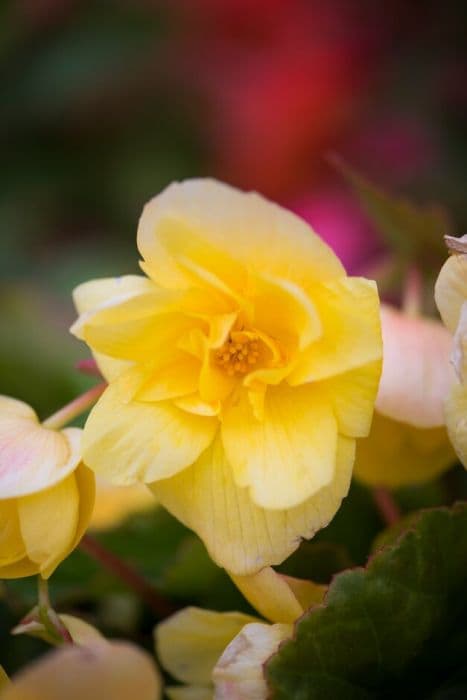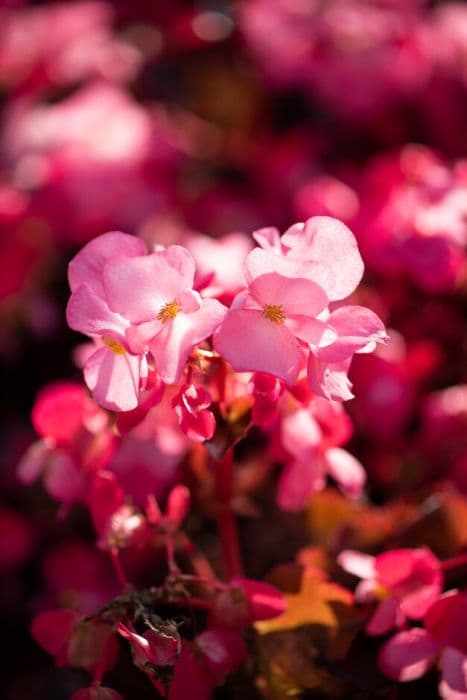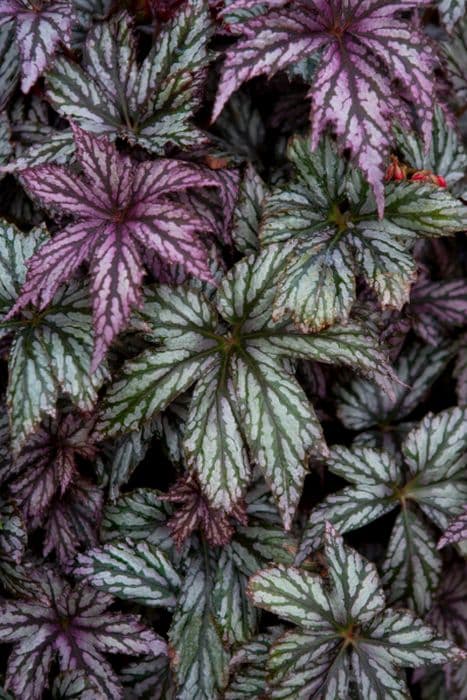Metallic Begonia Begonia metallica

ABOUT
Begonia metallica is a striking species distinguished by its unique foliage. The leaves of this plant have an unusual metallic sheen, which gives the plant its common name. The leaves are typically a dark green color with a hint of red or purple and the metallic effect makes the surface of the leaves appear to shimmer when light catches them at certain angles. The underside of the leaves often exhibit a reddish-purple tone, adding to the plant's overall allure. The leaves themselves are broad with a textured surface, featuring prominent veins that give them a somewhat puckered appearance. The edges of the leaves are softly serrated, giving each leaf a gently wavy outline. Begonia metallica also blooms, producing small clusters of flowers that may be pale pink, white, or light rose in color, though the flowers are often less noticeable compared to the captivating foliage. This plant's overall presentation is one of lushness and vibrant colors, with the striking contrast between the top and bottom of the leaves making it a favored choice for indoor gardeners and enthusiasts of begonias. The appearance of Begonia metallica, with its metallic glow and richly colored leaves, contributes to its popularity among those seeking to add tropical or exotic elements to their living spaces.
About this plant
 Names
NamesSynonyms
Metallic Begonia, Metal-Leaf Begonia
Common names
Begonia metallica.
 Toxicity
ToxicityTo humans
Begonia metallica, commonly known as Metallic Begonia, is not considered highly toxic to humans. However, it contains insoluble oxalates which can cause irritation when ingested. If parts of the plant are consumed, it can lead to symptoms such as a burning sensation in the mouth, tongue, and lips, as well as difficulty swallowing, and nausea. In most cases, ingestion of small quantities is unlikely to cause severe poisoning but can result in discomfort or irritation.
To pets
Metallic Begonia is considered toxic to pets due to the presence of insoluble oxalates. If ingested by animals such as cats or dogs, it can lead to oral irritation, drooling, vomiting, and difficulty swallowing. In severe cases, ingestion can lead to more serious symptoms such as changes in kidney function, but this is rare. Pet owners are advised to prevent their animals from eating any part of the plant to avoid these adverse effects.
 Characteristics
CharacteristicsLife cycle
Perennials
Foliage type
Evergreen
Color of leaves
Metallic green
Flower color
Pink
Height
1-2 feet (30-60 cm)
Spread
1-2 feet (30-60 cm)
Plant type
Herb
Hardiness zones
10
Native area
South America
Benefits
 General Benefits
General Benefits- Decorative Appeal: Begonia metallica has striking foliage with a metallic sheen, making it a visually attractive addition to indoor spaces.
- Low Maintenance: This plant typically requires minimal care, making it suitable for beginners or those who do not have a lot of time for plant care.
- Improves Humidity: By releasing moisture into the air through transpiration, Begonia metallica can help maintain indoor humidity levels.
- Emotional Well-being: The presence of plants like Begonia metallica in living and working spaces has been associated with reduced stress and increased feelings of happiness.
- Cognitive Boost: Interacting with plants, including Begonia metallica, has been shown to improve concentration, memory, and productivity.
 Medical Properties
Medical Properties Air-purifying Qualities
Air-purifying QualitiesThis plant is not specifically known for air purifying qualities.
 Other Uses
Other Uses- The leaves of Begonia metallica can be used in arts and crafts to create nature-inspired designs because of their unique texture and metallic sheen.
- The plant can serve as a living ornament during festive seasons, being a decorative piece with its shiny foliage when placed in decorative pots or combined with holiday decorations.
- Photographers sometimes use Begonia metallica as a background plant in portraits and macro photography due to its reflective leaves that can provide a natural, aesthetic backdrop.
- It's sometimes utilized in terrariums as a focal point because of its striking appearance and ability to thrive in high-humidity environments.
- The plant can act as an educational tool for botany enthusiasts or in classrooms to demonstrate the diversity of leaf textures and plant adaptations in the Begonia genus.
- Begonia metallica might be included in design and architecture visualizations to show potential landscaping options with exotic plants.
- Fine dining restaurants could use the leaves as non-toxic, decorative elements on buffet displays or as part of the plating aesthetics, though the leaves themselves are not edible.
- Event planners might incorporate Begonia metallica into botanical-themed events or weddings as part of the centerpieces or venue decoration to add a touch of elegance.
- The shiny leaves could be used as a natural reflector in small photography studios when a subtle reflection of light is needed.
- Some people might use Begonia metallica as part of a living jewelry display where the plant serves as an organic backdrop to highlight the beauty of the jewelry pieces.
Interesting Facts
 Feng Shui
Feng ShuiThe Begonia is not used in Feng Shui practice.
 Zodiac Sign Compitability
Zodiac Sign CompitabilityThe Begonia is not used in astrology practice.
 Plant Symbolism
Plant Symbolism- Caution or Beware - The Begonia often symbolizes caution or warning due to its delicate structure and the need for careful handling.
- Uniqueness - Begonia metallica, with its metallic sheen, represents uniqueness or standing out, as its appearance is unusual and eye-catching.
- Harmony - Despite its striking appearance, Begonias often grow in harmonious clusters, thereby symbolizing togetherness and harmony amidst diversity.
- Gratitude - Given as a gift, Begonias can symbolize gratitude or appreciation, communicating thankfulness in a relationship or friendship.
 Water
WaterMetallic Begonia prefers soil that is consistently moist but not waterlogged. Water the plant when the top inch of soil feels dry to the touch, which is roughly once every week, depending on environmental conditions. Use lukewarm water and aim to provide enough water to moisten the soil without leaving the plant sitting in excess water. Generally, this means you may water with around 16-24 ounces each time for a standard indoor pot size. Always check the soil moisture before watering to prevent overwatering, which can lead to root rot.
 Light
LightMetallic Begonia thrives in bright, indirect light. It's best placed near an east or west-facing window where it will receive some morning or late afternoon sun but is protected from the harsh midday rays. Avoid direct sunlight, especially during summer, as it can scorch the leaves of the plant, and keep it away from deep shade as this can lead to leggy growth and fewer leaves.
 Temperature
TemperatureThe ideal temperature range for Metallic Begonia is between 65 to 75 degrees Fahrenheit. It can survive minimum temperatures of about 60 degrees Fahrenheit and maximum temperatures around 86 degrees Fahrenheit. Keep the plant away from drafts and sudden temperature fluctuations to maintain consistent growing conditions.
 Pruning
PruningPrune Metallic Begonia to maintain its shape and encourage bushier growth. It's best to prune in the spring as new growth begins. Remove any dead or damaged leaves and stems, and you can also trim back leggy growth to promote a more compact plant. Pruning every few months or as needed to remove unwanted growth can keep your Begonia looking its best.
 Cleaning
CleaningAs needed
 Soil
SoilBegonia metallica, commonly known as Metallic Begonia, thrives in a well-draining soil mix that can be made by combining two parts peat moss with one part perlite or coarse sand to enhance drainage. The pH for Metallic Begonia should ideally be maintained slightly acidic to neutral, around 5.5-6.5.
 Repotting
RepottingMetallic Begonia should be repotted every 2-3 years or when it becomes root-bound. Repotting is best done in the spring or early summer to give the plant ample time to establish itself before the dormant period.
 Humidity & Misting
Humidity & MistingMetallic Begonia prefers high humidity levels, ideally between 60-70%. If the air in your home is dry, it may benefit from the use of a humidifier or regular misting to maintain these humidity conditions.
 Suitable locations
Suitable locationsIndoor
Grow Metallic Begonia indoors with bright, indirect light and high humidity.
Outdoor
Keep Metallic Begonia in shaded areas when grown outdoors and protect from frost.
Hardiness zone
10-11 USDA
 Life cycle
Life cycleBegonia metallica, commonly known as Metallic Begonia, begins its life cycle when its seeds germinate in a warm, humid environment with indirect light. The seedlings emerge and develop into young plants, sprouting characteristic heart-shaped, metallic-looking leaves with red undersides and a lush, bushy growth habit. As the plant matures, it forms a tuberous base that stores energy and allows it to endure less than ideal conditions. During its active growth period, typically in the spring and summer, the Metallic Begonia may produce small, pink or white flowers, although the plant is primarily grown for its attractive foliage. After flowering, the plant goes into a period of dormancy, particularly in cooler climates, where it may lose leaves and appear to die back, conserving energy in its tuber. With the return of favorable growing conditions, the tuber will sprout new growth, and the plant re-enters its vegetative state, thus continuing its perennial cycle.
 Propogation
PropogationPropogation time
Spring-Early Summer
Propogation: The Begonia metallica, commonly known as Metallic Begonia, is best propagated during its active growth period, which is usually in the spring or early summer. The most popular method to propagate it is through stem cuttings. To do so, select a healthy, non-flowering stem and cut a 4 to 6-inch (10 to 15 cm) length just below a node using a clean, sharp knife or scissors. Remove the leaves from the lower half of the cutting to expose the nodes. These nodes are where new roots will emerge. Plant the cutting in a well-draining potting mix, ensuring at least one or two nodes are buried in the soil. Keep the soil consistently moist but not soggy, and maintain a high humidity environment if possible. Bright, indirect light will help facilitate rooting, which typically occurs in a few weeks. Once the cutting has established a robust root system, it can be treated as a mature plant.





![Begonia [Devotion]](/_next/image?url=https%3A%2F%2Fplants-admin.emdemapps.com%2Fimages%2Fplants%2F%2Fimages%2F604b58183573b.png&w=640&q=75)



